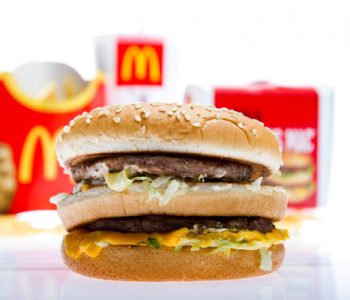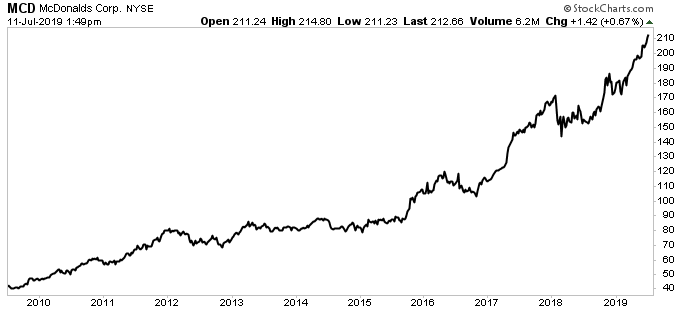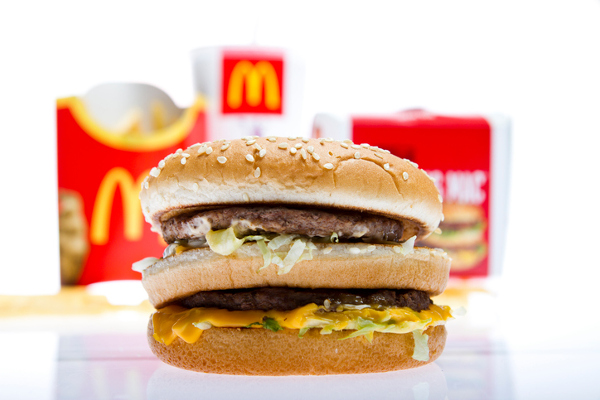McDonald’s Corp: 1 Top Dividend Stock for Buy-and-Hold Investors

Buy-and-Hold Investors Should Consider These Top Dividend Stocks
If you’re looking for top dividend stocks to possibly buy and hold, then you need to pay attention to two of the most important numbers in business: 80 and 20.
The 80/20 rule, also known as the Pareto principle, says 80% of the results come from 20% of the causes.
In the world of business, smart companies exploit this effect by zeroing in on the smallest, most lucrative parts of their sector. Then they make their investors rich by exploiting the most profitable 20% of activities, leaving the hard work to others.
Many top dividend stocks adhere to this rule. Apple Inc. (NASDAQ:AAPL) designs and markets electronics, contracting out capital-intensive, low-return activities like manufacturing. PepsiCo, Inc. (NASDAQ:PEP) collects royalties by selling syrup for soft drinks, then leaves the task of bottling and retail to partners. Intel Corporation (NASDAQ:INTC) works only in the most lucrative part of the personal computer business: designing and manufacturing semiconductors.
Another case in point: McDonald’s Corp (NYSE:MCD). The fast-food chain started out as a single restaurant in San Bernardino, California. Today the business has grown to almost 38,000 locations worldwide, serving everything from hamburgers and french fries to milkshakes and soft drinks.
But here is where things get interesting. Most people assume that McDonald’s makes its money from fast food sales at restaurants. In fact, the company only owns a handful of the locations. Instead, corporate management contracts out the job of actually running storefronts, collecting royalties on the sale of each meal.
This makes a lot of sense when you think about it. Owning a restaurant represents a poor investment risk. New locations are costly to build and competition keeps margins tight. That explains why the industry has a failure rate far worse than other industries.
To get around this problem, McDonald’s cherry-picks the most profitable part of the restaurant business: branding and marketing. In other words, the 20% of the business that generates 80% of the profits. The rest, management leaves to its partners, who have to bear most of the costs of building and running the company’s stores.
You can see the profitability of this arrangement in McDonald’s Corp’s financial results. Last year, the company’s gross margins topped 51%. Since 2009, the company has generated $0.21 in average annual profit on every dollar of capital invested into the business. I can only list a handful of top dividend stocks in the world that profitable.
So where does all this money go? Shareholders. McDonald’s Corp has about tripled the size of its dividend since 2009. “Dividend History,” McDonald’s Corp, last accessed July 12, 2019.)
Over the past five years, McDonald’s has spent $46.3 billion in combined dividends and stock buybacks. (Source: “McDonald’s Corp.,” MarketWatch, last accessed July 12, 2019.)
And as you can see in the below stock chart, McDonald’s shareholders have cashed in. Since late 2009, Coca-Cola stock has delivered a total return, including dividends, of 407%. That beats the pants off the gain from the broader S&P 500, with much less risk.

Chart courtesy of StockCharts.com
If you think about it, the benefits of buying an 80/20 business are obvious.
Take two stocks in the same industry. One company has to front the expense of properties, plants, and equipment. The other structures itself as a royalty firm with zero capital costs.
Over the long haul, which firm do you think is most likely to have rewarded its shareholders better? The answer, of course, is the company that has figured out the concept of 80/20.
McDonald’s Corp presents a textbook example. By focusing on only the most profitable part of the fast food business, the company enjoys 80% of the industry’s profits while fronting only 20% of the capital. That makes this one top dividend stock for buy-and-hold investors to consider.











